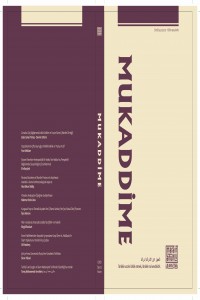Öz
Human first started domesticating
animals at least 11,000 years ago in the Levant and Central Anatolia. Gradually
the idea of animal controlling process, along with agricultural practice,
spread throughout Africa, Asia and continental Europe and eventually
transformed the face of the world. Archaeozoological evidences suggest that the
process of animal domestication was actually occurred in a new way of
human-animal interactions which was totally unknown to previous
hunter-gatherers. Mardin region is located in the central point of northern
Fertile Crescent. Archaeological settlements near and around this region provide
the evidence of human-animal relationships in Early Neolithic societies which essentially
promoted the early domestication process. However, the dimensions of present
human-animal interactions are far different than the early stage, and
therefore, Mardin region is a crucial place to study different facts and status
in pastoral societies, particularly focusing on anthrozoological perspectives. Unfortunately
very few attempts have yet been taken regarding this issue in southeast
Anatolia. This field research, thus, aimed to observe the status of pastoralism
and human-animal relationships in pastoral societies of Mardin providence.
Anahtar Kelimeler
Anthrozoology Anthropology Pastoralism Mardin Southeast Anatolia
Kaynakça
- Anggoro, F. K., Waxman, S. R. & Medin, D. L. (2008). ‘Naming Practices and the Acquisition of Key Biological Concepts: Evidence from English and Indonesian’, Psychological Science19 (4): 314-319.
- Arbuckle, B. S. (2014). ‘Pace and Process in the Origins of Animal Husbandry in Neolithic Southwest Asia’, Bioarchaeology of the Near East 8: 53-81.
- Backsheider, A., Shatz, M., & Gelman, S. (1993). ‘Preschoolers’ ability to distinguish living kinds as a function of regrowth’, Child Development 64: 1242-1257.
- Bacon, E. E. (1954). ‘Types of pastoral nomadism in Central and Southwest Asia’, Southwestern Journal of Anthropology, 10 (1): 44-68.
- Barfield, T. (1981). The Central Asian Arabs of Afghanistan; Austin: University of Texas Press.
- Bellwood, P. & Oxenham, M. (2008). ‘The expansions of farming societies and the role of the Neolithic demographic transition’, In: Bocquet-Appel, J. & Bar-Yosef, O. (eds.), The Neolithic Demographic: Transition and its consequences; Springer: 13-34.
- Blench, R. M. (2001). ‘You can’t go home again’ Pastoralism in the new millennium, http://www.org.odi.uk/staff/r.blench (Accessed on 23.10.2016).
- Bonfiglioli, A. M. (1993). ‘Agro-Pastoralism in Chad as a strategy for survival’, World Bank Technical Paper 214; Washington DC: World Bank.
- Brochier, J. E. (1993). ‘Çayönü Tepesi: domestication, rythmes and environment of PPNB’, Paléorient 19 (2): 39-49.
Öz
Human first started domesticating
animals at least 11,000 years ago in the Levant and Central Anatolia. Gradually
the idea of animal controlling process, along with agricultural practice,
spread throughout Africa, Asia and continental Europe and eventually
transformed the face of the world. Archaeozoological evidences suggest that the
process of animal domestication was actually occurred in a new way of
human-animal interactions which was totally unknown to previous
hunter-gatherers. Mardin region is located in the central point of northern
Fertile Crescent. Archaeological settlements near and around this region provide
the evidence of human-animal relationships in Early Neolithic societies which essentially
promoted the early domestication process. However, the dimensions of present
human-animal interactions are far different than the early stage, and
therefore, Mardin region is a crucial place to study different facts and status
in pastoral societies, particularly focusing on anthrozoological perspectives. Unfortunately
very few attempts have yet been taken regarding this issue in southeast
Anatolia. This field research, thus, aimed to observe the status of pastoralism
and human-animal relationships in pastoral societies of Mardin providence.
Anahtar Kelimeler
Anthrozoology Anthropology Pastoralism Mardin Southeast Anatolia
Kaynakça
- Anggoro, F. K., Waxman, S. R. & Medin, D. L. (2008). ‘Naming Practices and the Acquisition of Key Biological Concepts: Evidence from English and Indonesian’, Psychological Science19 (4): 314-319.
- Arbuckle, B. S. (2014). ‘Pace and Process in the Origins of Animal Husbandry in Neolithic Southwest Asia’, Bioarchaeology of the Near East 8: 53-81.
- Backsheider, A., Shatz, M., & Gelman, S. (1993). ‘Preschoolers’ ability to distinguish living kinds as a function of regrowth’, Child Development 64: 1242-1257.
- Bacon, E. E. (1954). ‘Types of pastoral nomadism in Central and Southwest Asia’, Southwestern Journal of Anthropology, 10 (1): 44-68.
- Barfield, T. (1981). The Central Asian Arabs of Afghanistan; Austin: University of Texas Press.
- Bellwood, P. & Oxenham, M. (2008). ‘The expansions of farming societies and the role of the Neolithic demographic transition’, In: Bocquet-Appel, J. & Bar-Yosef, O. (eds.), The Neolithic Demographic: Transition and its consequences; Springer: 13-34.
- Blench, R. M. (2001). ‘You can’t go home again’ Pastoralism in the new millennium, http://www.org.odi.uk/staff/r.blench (Accessed on 23.10.2016).
- Bonfiglioli, A. M. (1993). ‘Agro-Pastoralism in Chad as a strategy for survival’, World Bank Technical Paper 214; Washington DC: World Bank.
- Brochier, J. E. (1993). ‘Çayönü Tepesi: domestication, rythmes and environment of PPNB’, Paléorient 19 (2): 39-49.
Ayrıntılar
| Bölüm | Makaleler |
|---|---|
| Yazarlar | |
| Yayımlanma Tarihi | 23 Kasım 2017 |
| Gönderilme Tarihi | 4 Mart 2017 |
| Yayımlandığı Sayı | Yıl 2017 Cilt: 8 Sayı: 2 |
Cited By
Common Animals for Elite Humans: the Late Ottoman Fauna from Mardin Fortress, Southeastern Anatolia (Turkey)
International Journal of Historical Archaeology
https://doi.org/10.1007/s10761-022-00657-4
ISSN: 1309-6087, e-ISSN: 2459-0711
Mukaddime is licensed under a Creative Commons Attribution-NonCommercial 4.0 International License (CC BY NC).


